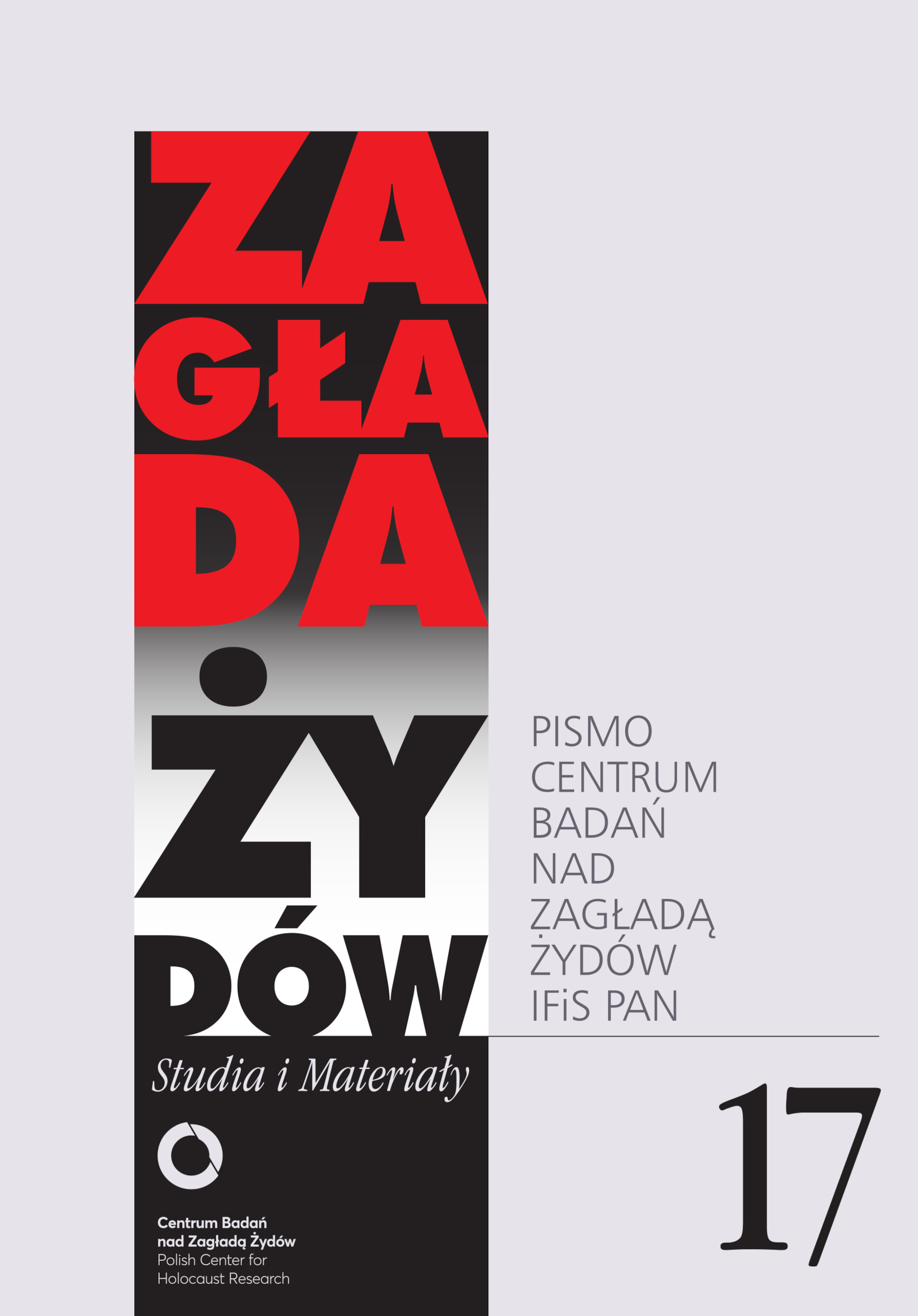Yolocaust: Platform Capitalism and Digital Holocaust Commemoration Practices
Zagłada Żydów. Studia i Materiały, No. 17 (2021), Pages: 358-375
Submission Date: 2021-12-18Publication Date: 2021-12-20
 https://doi.org/10.32927/zzsim.883
https://doi.org/10.32927/zzsim.883
Abstract
Online commemorations are associated with scandals and faux pases, but many content creators do not intend to offend anybody or become an object of online hate. Aside the existing methods of describing digital commemorations (content analysis, comparisons with the traditional media memory), the article makes use of netnography, that is observation and analysis of Internet users’ behavior. It also examines the ecosystem of the digital media in the context of platform capitalism. The research materials are: the yolocaust.de website, photographs of Auschwitz by Tomasz Lewandowski, and survivor Inge Ginsberg’s heavy metal performances.
References
Literatura / Luterature
Google Scholar
Anderson C.W. Practice, Interpretation, and Meaning in Today’s Digital Media Ecosystem, „Journalism & Mass Communication Quarterly” 2020, t. 97, nr 2.
Google Scholar
Ashman Rachel, Anthony Patterson, Stephen Brown, ‘Don’t Forget to Like, Share and Subscribe’. Digital Autopreneurs in a Neoliberal World, „Journal of Business Research” 2018, t. 92.
Google Scholar
Bareither Christoph, Difficult Heritage and Digital Media. ‘Selfie Culture’ and Emotional Practices at the Memorial to the Murdered Jews of Europe, „International Journal of Heritage Studies” 2021, t. 27, nr 1.
Google Scholar
Bishop Sophie, Managing Visibility on YouTube through Algorithmic Gossip, „New Media & Society” 2019, t. 21 nr 11/12.
Google Scholar
Burgess Jean, Remediating Vernacular Creativity. Photography and Cultural Citizenship in the Flickr Photo-sharing Network [w:] Spaces of Vernacular Creativity. Rethinking the Cultural Economy, red. Tim Edensor i in. London, New York: Routledge, 2010.
Google Scholar
Cayari Christopher, The YouTube Effect. How YouTube Has Provided New Ways to Consume, Create, and Share Music, „International Journal of Education & the Arts” 2011, t. 12, nr 6, s. 1–30.
Google Scholar
Citton Yves, The Ecology of Attention, Oxford: Polity, 2016.
Google Scholar
Dalziel Imogen, Becoming the ‘Holocaust Police’? The Auschwitz-Birkenau State Museum’s Authority on Social Media [w:] Digital Holocaust Memory, Education and Research, red. Victoria Grace Walden. London: Palgrave MacMillan, 2021.
Google Scholar
De Groot Jerome, Consuming History. Historians and Heritage in Contemporary Popular Culture, London: Routledge, 2016.
Google Scholar
Dubrofsky Rachel E., Frayed Edges. Selfies, Auschwitz, and a Blushing Emoticon, „a/b: Auto/Biography Studies” 2018, t. 33, nr 3.
Google Scholar
Duffy Brooke Erin, The Romance of Work. Gender and Aspirational Labour in the Digital Culture Industries, „International Journal of Cultural Studies” 2016, t. 19, nr 4.
Google Scholar
Ebbrecht-Hartmann Tobias, Lital Henig, i-Memory. Selfies and Self-Witnessing in #Uploading_Holocaust (2016) [w:] Digital Holocaust Memory, Education and Research, red. Victoria Grace Walden, London: Palgrave MacMillan, 2021.
Google Scholar
Eichhorn Kate, The End of Forgetting. Growing up with Social Media, Cambridge, MA: Harvard University Press, 2019.
Google Scholar
Gallardo Kristine L., Taming the Internet Pitchfork Mob. Online Public Shaming, the Viral Media Age, and the Communications Decency Act, „Vanderbilt Journal of Entertainment and Technology Law” 2017, t. 19, nr 3.
Google Scholar
Ginsberg Inge, Manfred Flügge, Die Partisanenvilla. Erinnerungen an Flucht, Geheimdienst und zahlreiche Schlager. München: Deutscher Taschenbuch Verlag, 2008.
Google Scholar
Goldberg Greg, Antisocial Media: Anxious Labor in the Digital Economy, New York: NYU Press, 2018.
Google Scholar
Kozinets Robert V., Netnografia: badania etnograficzne online, tłum. Maja Brzozowska-Brywczyńska, Warszawa: Wydawnictwo Naukowe PWN, 2012.
Google Scholar
Kozinets Robert V., Daiane Scaraboto, Marie-Agnès Parmentier, Evolving Netnography. How Brand Auto-netnography, a Netnographic Sensibility, and More-than-human Netnography Can Transform Your Research, „Journal of Marketing Management” 2018, t. 34, nr 3/4.
Google Scholar
Lewandowski Tomasz, Auschwitz – Fall of the Modern Age, Halle: Mitteldeutscher Verlag, 2019.
Google Scholar
Łysak Tomasz, Kultura popularna [w:] Reprezentacje Zagłady w kulturze polskiej (1939–2019), t. 2: Problematyka Zagłady w sztukach wizualnych i popkulturze, red. Sławomir Buryła, Dorota Krawczyńska, Jacek Leociak, Warszawa: Wydawnictwo IBL PAN, 2021.
Google Scholar
Łysak Tomasz, Vlogging Auschwitz. New Players in Holocaust Commemoration, „Holocaust Studies: A Journal of Culture and History” 2021, w przygotowaniu.
Google Scholar
Milbrandt Tara, Caught on Camera, Posted Online. Mediated Moralities, Visual Politics and the Case of Urban ‘Drought-Shaming’, „Visual Studies” 2017, t. 32, nr 1.
Google Scholar
Mirzoeff Nicholas, Jak zobaczyć świat, tłum. Łukasz Zaremba, Kraków–Warszawa: Wydawnictwo Karakter, Muzeum Sztuki Współczesnej w Warszawie, 2016.
Google Scholar
Netnography Unlimited, red. Robert V. Kozinets, Rossella Gambetti. New York: Routledge, 2020.
Google Scholar
Pomerantz Jeffrey, Metadata, Cambridge, MA: The MIT Press, 2015.
Google Scholar
Raine Michael, YouTube. Friend or Foe of the Music Industry?, „Canadian Musician” 2017, May/June https://indepth.canadianmusician.com/youtube-friend-or-foe-of-the-music-industry/.
Google Scholar
Scott Niall, Heavy Metal and the Deafening Threat of the Apolitical, „Popular Music History” 2011, t. 6, nr 1/2.
Google Scholar
Smiley Calvin John, From Silence to Propagation. Understanding the Relationship between „Stop Snitchin” and „YOLO”, „Deviant Behavior” 2015, t. 36, nr 1.
Google Scholar
Sorell Tom, Scambaiting on the Spectrum of Digilantism, „Criminal Justice Ethics” 2019, t. 38, nr 3.
Google Scholar
Srnicek Nick, Platform Capitalism. Cambridge: Polity, 2017.
Google Scholar
Van Es Karin, YouTube’s Operational Logic. „The View” as Pervasive Category, „Television & New Media” 2020, t. 21, nr 3.
Google Scholar
Walden Victoria Grace, Introduction. Defining the Digital in Digital Holocaust Memory, Education, and Research [w:] Digital Holocaust Memory, Education and Research, red. Victoria Grace Walden, London: Palgrave MacMillan, 2021.
Google Scholar
Wei Junhow, „I’m the Next American Idol”. Cooling Out, Accounts, and Perseverance at Reality Talent Show Auditions, „Symbolic Interaction” 2016, t. 39, nr 1.
Google Scholar
Williams Penny, Paula McDonald, Robyn Mayes, The Impact of Disruptive Innovation on Creative Workers. The Case of Photographers, „Creative Industries Journal” 2020, doi.org/10.1080/17510694.2020.1858707.
Google Scholar
Zuboff Shoshana, Wiek kapitalizmu inwigilacji: walka o przyszłość ludzkości na nowej granicy władzy, tłum. Alicja Unterschuetz, Poznań: Zysk i S-ka, 2020.
Google Scholar
Netografia / Netography
Google Scholar
America’s Got Talent, 6-Year-Old Aaralyn Screams Her Original Song, „Zombie Skin” – America's Got Talent, „YouTube.com”, 26 VI 2013, https://www.youtube.com/watch?v=VhQK-6iI7cI liczba wyświetleń 44 239 341.
Google Scholar
Eurovision Song Contest 2015, brak autora, „wikipedia.org”, brak daty, https://en.wikipedia.org/wiki/Eurovision_Song_Contest_2015.
Google Scholar
Eurovision Song Contest 2016, brak autora, „wikipedia.org”, brak daty, https://en.wikipedia.org/wiki/Eurovision_Song_Contest_2016.
Google Scholar
Kaze Jhony Feat Snippah, „Yolocaust” – Prod by Essem – Offizielles HD Video, „YouTube”, 20 III 2014, https://www.youtube.com/watch?v=KXZgq7QDeXY.
Google Scholar
Lewandowski Tomasz, zdj. i tekst, Auschwitz: Ultima Ratio of the Modern Age, „Lensculture.com”, brak daty, https://www.lensculture.com/articles/tomasz-lewandowski-auschwitz-ultima-ratio-of-the-modern-age.
Google Scholar
Lewandowski Tomasz, Auschwitz – Ultima Ratio of the Modern Age, „lensculture.com”, brak daty, https://www.lensculture.com/projects/522941-auschwitz-ultima-ratio-of-th.
Google Scholar
Lewandowski Tomasz, Auschwitz – Ultima Ratio of the Modern Age / 2017, „tomaszlewandowski.de”, brak daty, https://www.tomaszlewandowski.de/lewandowski/auschwitz-ultima-ratio-of-the-modern-age/.
Google Scholar
MAKJ Causes Uproar With Controversial Photo Taken at Berlin Holocaust Memorial, brak autora, „Thissongslaps.com”, 28 VIII 2014, https://www.thissongslaps.com/2014/08/makj-causes-uproar-with-controversial-photo-taken-at-berlin-holocaust-memorial/.
Google Scholar
ManhattanCamerata, 93yo Metal Grandma Holocaust Survivor Spy! „Totenköpfchen” (Laugh at Death) -Swiss Eurovision 2015, „YouTube.com”, 31 X 2014, https://www.youtube.com/watch?v=TUxOnM0daAk.
Google Scholar
ManhattanCamerata, 96yo Metal Grandma Holocaust Survivor „The Universe Echoes Back” Inge Ginsberg & the TritoneKings, „YouTube.com”, 18 VII 2018, https://www.youtube.com/watch?v=5OutYNwpbKw.
Google Scholar
Orzechowski Hubert, Yolocaust. Pomyśl, zanim zrobisz selfie, „Newsweek”, 20 I 2017, https://www.newsweek.pl/kultura/wydarzenia/yolocaust-co-to-jest-selfie-w-miejscach-pamieci-zaglady/1we1mkr.
Google Scholar
SRF Stadt Land Talent, Heavy Metal-Granny Inge Ginsberg rockt mit der Eigenkomposition Trümmer, „YouTube.com”, 20 II 2016, https://www.youtube.com/watch?v=Nr29SMyiM8M.
Google Scholar
Tritoneking, 94yo Heavy Metal Grandma Holocaust Survivor Spy! „Trümmer” The TritoneKings (Swiss Eurovision 2016), „YouTube.com”, 29 X 2015, https://www.youtube.com/watch?v=ABKIQTKzY5U.
Google Scholar
Tritoneking, Heavy metal granny Inge & the TritoneKings rocks the stage with her own song „Trümmer”, „YouTube.com”, 20 II 2016, https://www.youtube.com/watch?v=pRLvbvhQ8KU.
Google Scholar
Watemborski Marcin, Yolocaust to selfie na szczątkach ofiar holocaustu. Mocna seria zdjęć obnażająca brak szacunku dla ludzkiej tragedii, „Fotoblogia”, brak daty, https://fotoblogia.pl/10144,yolocaust-co-jest-wazniejsze-selfie-czy-szacunek-dla-ludzkiej-tragedii.
Google Scholar
License
Copyright (c) 2021 Author&"Holocaust Studies and Materials"

This work is licensed under a Creative Commons Attribution 4.0 International License.
https://creativecommons.org/licenses/by/4.0
The journal is published under the Diamond Open Access Standard, CC-BY-4.0 Deed - Attribution 4.0 International - Creative Commons
Most read articles by the same author(s)
- Tomasz Łysak, ENCYCLOPEDIA of Holocaust Literature. Volume 1-2 , Zagłada Żydów. Studia i Materiały: No. 2 (2006)
Similar Articles
- Dan Michman, Dutch Society and the Jewish Fate: A Puzzling Record , Zagłada Żydów. Studia i Materiały: No. 12 (2016)
- Jacek Leociak, Understanding the Holocaust. A Task for Generations , Zagłada Żydów. Studia i Materiały: 2008: Holocaust Studies and Materials
- Jacek Leociak, Marta Tomczok, Affective Holocaust Kitsch – Introduction , Zagłada Żydów. Studia i Materiały: No. 17 (2021)
- Anna Abakunkova, Contemporary Holocaust Studies in Ukraine , Zagłada Żydów. Studia i Materiały: No. 10 (2014)
- Justyna Kowalska-Leder, Polish Literature of the Last Decade about the Holocaust – Attempts to Face the New Challenges , Zagłada Żydów. Studia i Materiały: No. 10 (2014)
- Roni Stauber, Philip Friedman and the Beginning of Holocaust Studies , Zagłada Żydów. Studia i Materiały: No. 11 (2015)
- Marta Duch-Dyngosz, In Search of Local Memory of the Holocaust. The Case of Commemoration of Jewish Communities in Smaller Towns in Contemporary Poland , Zagłada Żydów. Studia i Materiały: No. 17 (2021)
- Katrin, One-Way Schedule. Interrogations of Former Reichsbahn Clerks Regarding the Deportation of Jews from Prużany to Auschwitz in 1943 , Zagłada Żydów. Studia i Materiały: No. 12 (2016)
- Przemysław Czapliński, The Holocaust as a Horror. A Handful of Comments on Polish Literature during 1985–2015 , Zagłada Żydów. Studia i Materiały: No. 12 (2016)
- Agnieszka Haska, Auschwitz from Auschwitz or how to write a bestseller , Zagłada Żydów. Studia i Materiały: No. 16 (2020)
1 2 3 4 5 6 7 8 9 10 11 12 13 14 15 16 17 18 19 20 21 22 23 24 25 26 27 28 29 30 31 32 33 34 35 36 37 38 39 40 41 42 43 44 45 46 47 48 49 50 > >>
You may also start an advanced similarity search for this article.
 English
English
 Język Polski
Język Polski



 https://orcid.org/0000-0002-5476-4917
https://orcid.org/0000-0002-5476-4917

